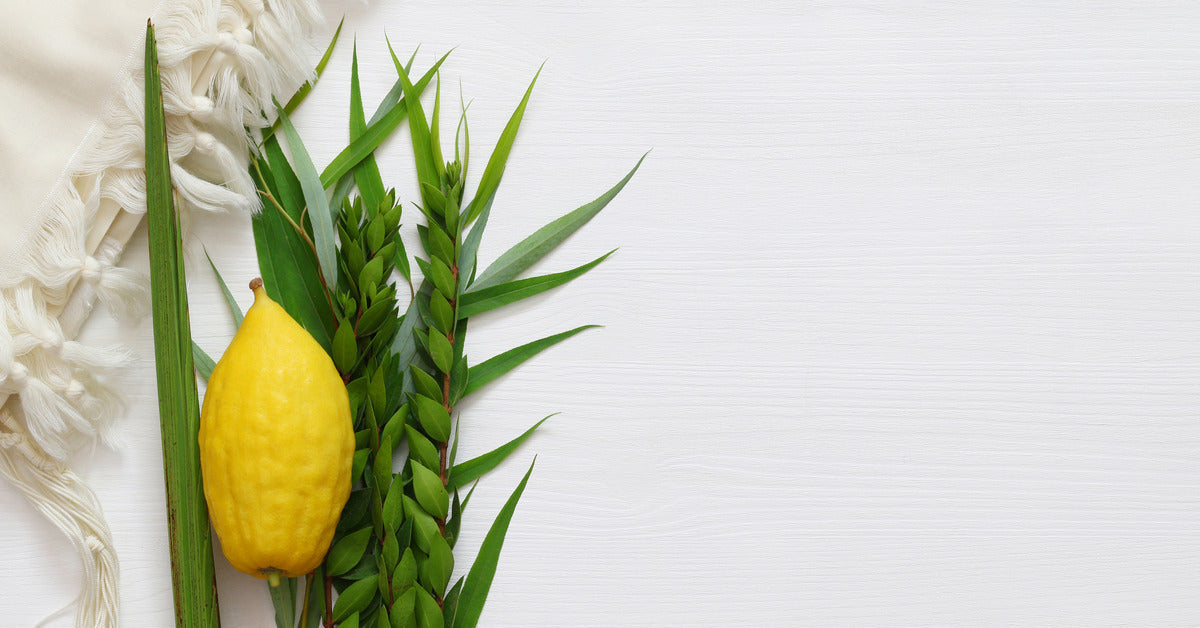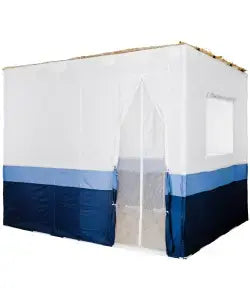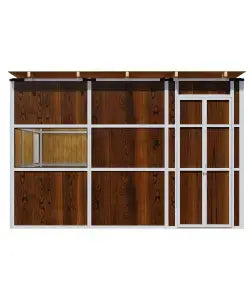How to Celebrate Sukkot with 5 Joyful and Meaningful Ideas

What is Sukkot, and How is It Celebrated?
Sukkot, known as the "Festival of Booths," is a joyful and spiritually rich Jewish holiday that begins on the 15th of Tishri. It commemorates the Israelites’ journey through the wilderness after the Exodus from Egypt, during which they relied on God's protection while dwelling in temporary shelters. Today, that journey is honored by building and decorating a sukkah, a temporary outdoor booth where families eat meals, reflect on their blessings, and, in many cases, sleep during the week-long celebration.
Sukkot Traditions with Fresh Inspiration: Candle Lighting, Blessings, and Celebration Tips
Sukkot also marks the fall harvest and blends themes of gratitude, faith, and community. One of its central mitzvot is waving the Four Kinds, lulav, etrog, hadassim (myrtle), and aravot (willow), as a symbol of unity and divine connection. The first two days (one in Israel) are observed as Yom Tov, sacred festival days where work is prohibited and candles are lit before festive meals.
If you're wondering how to celebrate Sukkot that feels fresh yet stays rooted in tradition, you're in the right place. With a little creativity, you can infuse your Sukkot with joyful energy and meaningful connection. Read on for ideas that can make this year's celebration truly unforgettable.
Before lighting the candles, recite the following blessing:
-
Bah-rookh ah-tah ah-doh-noi eh-loh-hay-noo meh-lekh hah-oh-lahm ah-sher ki-deh-shah-noo beh-mitz-voh-tahv veh-tzee-vah-noo leh-hahd-lik nayr shehl (shah-baht veh-shehl) yohm tohv.
(Blessed are You, Lord our God, King of the Universe, who has sanctified us with His commandments and has commanded us to kindle the light of (Shabbat and of) the Festival Day.)
Hoshanot and Hoshanah Rabbah
During Sukkot, we recite Hallel (psalms of praise) every day of the festival, and we perform the Hoshanot ritual, where we circle the bimah with the Four Kinds. On the seventh day of Sukkot, Hoshanah Rabbah, we perform the ritual with greater intensity, symbolizing final judgment and divine mercy. This day is marked by reciting additional prayers and striking the ground with willows as an expression of repentance and seeking divine assistance.
Water Libation and Joyful Celebrations
Simchat Beit Hasho’eva, or the water libation ceremony, was a joyous event in the Temple where water was poured over the altar, symbolizing the coming rains. While this practice no longer exists, it is still commemorated through joyous singing and dancing throughout the holiday. These celebrations are central to the joy of Sukkot, reflecting our connection to nature and divine providence.
Shemini Atzeret and Simchat Torah
Shemini Atzeret and Simchat Torah mark the conclusion of Sukkot, with Shemini Atzeret being a separate holiday that focuses on prayers for rain and harvest. On Simchat Torah, we celebrate the completion of the annual Torah reading cycle with dancing and rejoicing in the synagogue. Although Simchat Torah follows Sukkot, it is a distinct celebration where the Four Kinds are not used, and the mitzvah of dwelling in the sukkah is not observed.
How Long is Sukkot Celebrated?
The festival lasts for seven days in Israel and eight days in the diaspora, with the first two days (or nights) treated as full festival days where work is forbidden and candles are lit, just like on Shabbat. After these first two days, the rest of Sukkot is still celebrated with joy, meals in the sukkah, and rituals like waving the four kinds: lulav, etrog, myrtle, and willow, a special ceremony commanded in the Torah and led in the synagogue each morning.
Sukkot 2025 Dates
Sukkot 2025 will begin at nightfall on October 6 and end at nightfall on October 13. Following Sukkot, Shemini Atzeret and Simchat Torah will be observed from October 13-15. These dates are important for those who are preparing for Sukkot 2025, so marking them will help your readers plan better.
Chol Hamoed (Intermediate Days)
The days in between the first and last days of Sukkot are known as Chol Hamoed. These days are quasi-holidays, meaning work is permitted, but the spirit of the holiday still prevails. Chol Hamoed offers a great opportunity for family bonding and communal activities, such as daily meals in the sukkah and taking the Four Kinds.
Before waving the Four Kinds, the following blessing is recited:
-
Bah-rookh ah-tah ah-doh-noi eh-loh-hay-noo meh-lekh hah-oh-lahm ah-sher ki-deh-shah-noo beh-mitz-voh-tahv veh-tzee-vah-noo ahl neh-tee-laht loo-lahv.
(Blessed are You, Lord our God, King of the Universe, who has sanctified us with His commandments and commanded us regarding taking the lulav.)
This ritual is a reminder of the unity of creation, as we wave the Four Kinds in all six directions (north, south, east, west, up, and down).
What is the Meaning of Sukkot?
The meaning of Sukkot goes beyond tradition; it’s about acknowledging divine protection, celebrating the harvest, and connecting deeply with family and faith. In 2024, Sukkot begins at nightfall on October 16 and ends at sundown on October 23, followed by Shemini Atzeret and Simchat Torah, two days that conclude this season of awe and gratitude.
The Deeper Significance of Sukkot Traditions
Spiritual Depth of Sukkot:
-
While decorating the sukkah and celebrating outdoors bring joy and community togetherness, it’s crucial to also reflect on the spiritual depth that makes Sukkot meaningful.
-
Every custom, whether it's waving the Four Kinds or dwelling in the sukkah, is rooted in Torah commandments and rich symbolism.
The Sukkah as a Spiritual Space:
-
The sukkah represents the temporary shelters the Israelites used during their 40 years in the wilderness.
-
Sitting or sleeping in the sukkah connects us with that ancient journey and reminds us that physical comfort is fleeting, and true protection comes from above.
-
Even the sukkah’s structure has spiritual layers:
-
The roof (schach) must be made of natural materials, allowing you to see the stars, a physical reminder of our connection to creation and the divine.
The Four Kinds (Arba Minim):
-
One of the central mitzvot of Sukkot is to take the Four Kinds (lulav, etrog, myrtle, and willow) and wave them in all directions.
-
According to Torah texts, this action symbolizes the unity of all aspects of creation and the gathering of blessings.
-
In many communities, this ceremony is performed daily in the synagogue, accompanied by joyful singing, Torah readings, and praise from Psalms.
-
It’s a moment filled with movement, meaning, and mindfulness.
Participation in Mitzvot:
-
Sukkot provides a powerful opportunity for Jewish women and children to engage in hands-on mitzvot.
-
Tasks such as decorating the sukkah, lighting candles, and preparing meals contribute to the sanctity of the space.
-
Many families incorporate verses like "Baruch Atah Adonai, Eloheinu Melech ha-olam" as part of their rituals, deepening the sense of holiness.
Essence of Sukkot:
-
The festival lies in gratitude, humility, and community.
-
Even if you’re gathering under the stars or shaking the lulav with others in your synagogue, every action ties back to a shared legacy of faith and joy.
Need more practical info on decorating or building your sukkah? Feel free to visit our FAQs page for helpful tips and answers to common questions.
Blessing for Dwelling in the Sukkah:
-
Bah-rookh ah-tah ah-doh-noi eh-loh-hay-noo meh-lekh hah-oh-lahm ah-sher ki-deh-shah-noo beh-mitz-voh-tahv veh-tzee-vah-noo lay-shayv bah-soo-kah.
(Blessed are You, Lord our God, King of the Universe, who has sanctified us with His commandments, and commanded us to dwell in the sukkah.)
This blessing is recited before eating or dwelling in the sukkah, connecting us to the divine protection that the sukkah represents.
No. 1 - Reimagine Your Sukkah
Creating a sukkah is at the heart of Sukkot celebrations, and there are numerous ways to infuse creativity into its construction and decoration. Once the basic structure is in place, encourage family and friends to contribute by creating DIY decorations such as paper garlands, painted pumpkins, or handmade lanterns that can be hung from the walls and ceiling. Incorporate themes of nature and gratitude into your decor by adding fresh autumnal produce like gourds, apples, and colorful leaves. Personalize the space with photos, quotes, or poetry that reflect the warmth and togetherness that Sukkot represents. This communal approach not only improves overall aesthetics but also fosters a sense of connection among those who participate.
To further improve the Sukkot experience, consider integrating activities or themes that go beyond traditional meals. Experience the diversity within the Jewish diaspora by hosting themed nights, such as a multicultural evening where everyone brings a dish with international flavors. Alternatively, plan an evening of storytelling or music sessions within the sukkah, perhaps inviting local musicians or storytellers to partake in a cultural exchange. These interactive elements add layers of engagement and meaning to the celebrations, ensuring the memories created in the sukkah are cherished for years to come.
Detailed Laws of Building a Sukkah
When constructing your sukkah, there are halachic guidelines that need to be followed to ensure its validity. You must have at least three walls, and the roof (schach) should be made from unprocessed natural materials like bamboo, palm fronds, or reed stalks. Wood, plastic, and other man-made materials are not permissible for sukkah walls or the roof. The sukkah should also be open to the sky, meaning there should be no roof or tree directly above it.

No. 2 - Bring the Sukkah Decor Indoors
Just because Sukkot primarily centers around the sukkah doesn't mean the rest of your home should miss out on the festive spirit. Extend the theme of the holiday by incorporating Sukkot-inspired decorations inside your home, creating a seamless transition between spaces, and maintaining the festive ambiance throughout the week. Start by adorning mantels, shelves, and tables with the same natural elements used in the sukkah, such as autumn-colored leaves, small pumpkins, and vibrant gourds. Consider crafting a centerpiece with these items for your dining table, complete with candles or fairy lights that add warmth and coziness to the interior spaces.
In addition to the natural decor, you can bring in elements of the sukkah by hanging up fabric or paper wall hangings inspired by Jewish culture and symbolism. These could include patterns or imagery that reflect the themes of harvest and gratitude, or simply pieces with Hebrew calligraphy. Display family photos from past Sukkot celebrations in beautiful frames as a reminder of the tradition and its importance. These improvements ensure that the spirit of Sukkot permeates your entire living space, allowing every room to be part of the holiday's celebrations and keeping your connection with the sukkah during moments spent indoors.
No. 3 - Coordinate New Family Outfits
One way to embrace the Jewish tradition of starting anew with new clothing is to coordinate unique family outfits to wear during your Sukkot celebrations. To add a creative twist, plan a family outfit shopping day where each person gets to pick an accessory or piece of clothing that represents what they are thankful for. This outing can lead to interesting discussions and storytelling opportunities. This approach not only honors tradition but also ensures everyone feels special and connected as they come together to celebrate the holiday with a fresh perspective. Plus, it's a great excuse for the family to get nice clothing for the upcoming high holidays.
No. 4 - Enjoy All the Outdoors Have To Offer
Celebrating Sukkot offers the perfect opportunity to enjoy the great outdoors, with activities that bring families and communities together under the open sky. Start by organizing song nights within the sukkah or under the stars. Invite family, friends, or community members to gather with musical instruments if available, and create a cozy setting with comfortable seating, blankets, and pillows. Choose a selection of traditional Jewish songs, folk tunes, or any favorites that everyone can sing along to. These evenings can be as casual or organized as you desire. The experience of singing together in the crisp autumn air not only lifts spirits but also strengthens bonds.
Another delightful outdoor activity is stargazing, which can be an awe-inspiring experience for both children and adults. Choose a clear night to gaze at the constellations, invite an amateur astronomer from your community to share insights into the night sky's wonders, or simply use apps that identify stars and planets. Stargazing offers a moment of pause and reflection amidst the celebrations, reminding participants of the vastness of the universe and the beauty of creation, resonating powerfully with Sukkot's themes of awe and gratitude.
No. 5 - Have a Sukkah for Each Family Member
Creating a smaller sukkah for each family member can be an engaging and meaningful way to celebrate individuality and personal expression during Sukkot. This personalized approach allows family members to find their creativity while reflecting on what Sukkot means to them. The activity fosters a deeper connection to the holiday's themes of gratitude and reflection as each member decorates their sukkah with symbols, colors, and items that resonate personally. Displaying these small sukkahs collectively can also serve as a unique family exhibit, showcasing diverse perspectives and highlighting the beauty of unity within individuality. This practice not only emphasizes personal tradition but also improves family bonds, creating an intimate and memorable experience that everyone can cherish.

Make This Year’s Sukkot Easy, Meaningful, and Complete
Sukkah Market is here to help you spice up your holiday with quality products, fast shipping, and everything you need to create a memorable Sukkot experience. If you're still figuring out how to celebrate Sukkot in a more personal or practical way, our wide range of sukkah kits, decorations, and essentials can help bring your vision to life. Have questions or need help choosing the right products? Contact us today, and our team will be happy to guide you.
Prefer to shop in person? Visit one of our convenient store locations and get everything you need before the holiday begins. Don’t wait, start preparing for Sukkot now and make this year’s celebration one to remember.







